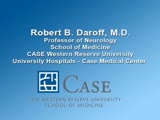The Robert B. Daroff Neuro-Ophthalmology Collection: Features a series of instructional video on eye movement disorders prepared in 1991. The original recordings were on 16mm film, mostly filmed in the 1960s and 70s in Dr. Daroff's laboratory at the University of Miami.
Robert B. Daroff, Professor and Chair Emeritus, School of Medicine, CASE Western Reserve University, University Hospitals - Case Medical Center.
NOVEL: https://novel.utah.edu/
TO
Filters: Date: "1991" Collection: "ehsl_novel_rbd"
| Title | Description | Type | ||
|---|---|---|---|---|
| 1 |
 |
Accomodative Gaze Palsy or Convergence Spasm | This is a psychogenic disorder that may mimic lateral rectus palsy. The clue is pupillary constriction during attempted lateral gaze. | Image/MovingImage |
| 2 |
 |
Alexander's Law | This describes the observed increase in vestibular nystagmus with gaze in the direction of the fast phase, and its decrease with gaze in the slow phase direction. | Image/MovingImage |
| 3 |
 |
Anatomy and Physiology of Nystagmus | The role of the cerebellum in modifying the output of the neural integrator is discussed. Impaired integration causes jerk nystagmus with increasing or decreasing velocity exponential slow phases. | Image/MovingImage |
| 4 |
 |
Anatomy and Physiology of the Saccade System | Saccades depend on a pulse-step firing pattern that allows an initiation of the saccade (pulse), and maintenance of the new eye position in space (step). This video explains the anatomical pathway for this type of activation. The burst cells, which lie in the PPRF, generate the pulse, while the nu... | Image/MovingImage |
| 5 |
 |
Bilateral Horizontal Gaze Palsy | A patient with a bilateral PPRF lesion displays intact vertical gaze and convergence. | Image/MovingImage |
| 6 |
 |
Bilateral Internulcear Ophthalmoplegia | A woman with a bilateral INO demonstrates impaired adduction and nystagmus of the abducting eyes. Her vertical gaze is intact. The dissociated optokinetic nystagmus, due to an inability of the medial recti to generate normal saccades, is again shown. | Image/MovingImage |
| 7 |
 |
Brain Stem Eye Movement Syndromes | In this series, the importance of the brainstem in eye movements is discussed, with particular emphasis is placed on the signficance of the paramedian pontine reticular formation (PPRF), the medial longitudinal fasciculus (MLF), and the nuclei and projections of cranial nerves III and VI. Correlat... | Image/MovingImage |
| 8 |
 |
Cerebellar Eye Signs | Lesions of the cerebellum can result in a variety of eye movement disorders, including saccadic intrusions and oscillations, such as ocular dysmetria, as well as nystagmus, gaze palsies, and dysfunction of the vestibular ocular reflex. In this series of videos, these disorders are discussed in rela... | Image/MovingImage |
| 9 |
 |
Cerebellar Eye Signs: Overview | The wide array of cerebellar eye signs, includes, among others, saccadic intrusions and oscillations, nystagmus, gaze palsies, and impairment of the vestibulo-ocular reflex. | Image/MovingImage |
| 10 |
 |
Cerebral Control of Eye Movements | In this series, the purpose and nomenclature of eye movements are described, with the anatomical pathways generating and controlling the cortically-driven movements -- saccades and smooth pursuit in horizontal gaze, upgaze and downgaze -- discussed in detail. The importance of each of the three sac... | Image/MovingImage |
| 11 |
 |
Chiari Malformation: Eye Movements | The eye movement disorders commonly accompanying Chiari malformations are listed. These are generally the same as with lesions of the cerebellum. | Image/MovingImage |
| 12 |
 |
Classifications of Internuclear Ophthalmoplegia | Both the Lutz and Cogan classifications of INO separate them into anterior and posterior varieties. The Cogan classification, which depends upon the presence or absence of convergence, is not particularly useful for localization. The Lutz posterior INO, which is a supranuclear pareses of abduction, ... | Image/MovingImage |
| 13 |
 |
Defective Pursuit | A patient with a cerebral hemispherectomy manifests ipsilateral low-gain (saccadic) pursuit, and impaired optokinetic nystagmus when the targets are moved towards the lesioned side. The multiple causes of pursuit abnormalities are discussed. | Image/MovingImage |
| 14 |
 |
Defective Saccades: Frontal Lobe Lesion | A patient with a right frontal lobe infarction demonstrates loss of saccades to the left with preservation of pursuit. | Image/MovingImage |
| 15 |
 |
Defective Saccades: Slow to No Saccades | In this video, the many causes of this syndrome are listed, and a patient demonstrates the consequence of being unable to generate saccadic eye movements. On cold caloric stimulation, his eyes deviate tonically to the side of the stimulation without fast phases to the opposite side. | Image/MovingImage |
| 16 |
 |
Downbeat Nystagmus | Primary position downbeat nystagmus is demonstrated, with a list of the common causes. | Image/MovingImage |
| 17 |
 |
Eye Movement Modeling; Eye-Ear Tricks | A surgical resident was able to combine eye and ear movements as a party trick, to intimidate a first year neurology resident. | Image/MovingImage |
| 18 |
 |
Eyelid Nystagmus | Lid nystagmus is of three types. The most common is associated with vertical ocular nystagmus with the lid movement being synchronous with the eyes, but with greater aplitutde. The second type is associated with gaze evoked horizontal nystagmus and may occur in the lateral medullary syndrome. A p... | Image/MovingImage |
| 19 |
 |
Gaze Evoked Ear Retraction | Large ears normally retract during ipsilateral gaze, as shown in this segment. However, it won't be noted unless you look for it. "You see what you look for, and you look for what you know." | Image/MovingImage |
| 20 |
 |
Gustatory Lid Retraction in Congenital Horner's Syndrome | A young girl with unilateral ptosis from a congenital Horner's syndrome demonstrates a distinctively rare phenomenon of resolution of the ptosis by sucking lemon juice. | Image/MovingImage |
| 21 |
 |
Horizontal Eye Movements | The anatomic pathway involved in horizontal saccadic eye movements include the frontal eye fields, paramedian pontine reticular formation (PPRF), medial longitudinal fasciculus (MLF), and cranial nerve nuclei III and VI. The pathway for the vestibulo- ocular reflex (VOR) passes through the PPRF at ... | Image/MovingImage |
| 22 |
 |
Internuclear Ophthalmoplegia | Lesions of the MLF cause an INO, which manifests as ipsilateral palsies of adduction, and nystagmus of the contralateral abducted eye. Vertical gaze is preserved. Inducing optokinetic nystagmus so that the adducting eye is responsible for the fast phase, causes a dissociation between the two eyes, a... | Image/MovingImage |
| 23 |
 |
Introduction to Eye Movements | This brief clip reveals how eye movements subserve vision, and provides an overview of each of the four eye movement systems: saccadic, smooth pursuit, vergence, and vestibular. | Image/MovingImage |
| 24 |
 |
Macro Square Wave Jerks | A woman with multiple sclerosis has a postural tremor and macro square wave jerks. These indicate a cerebellar outflow problem. Macro square wave jerks are somewhat of a misnomer since the eye movements are not entirely square; an alternate descriptor is "square wave pulses." | Image/MovingImage |
| 25 |
 |
Miscellaneous Ocular Oscillations | In this final series, several eye movement abnormalities are detailed with patients used to illustrate each. KEY WORDS: opsoclonus-myoclonus, opsoclonus, square wave jerks, macro square wave jerks, pause cell dysfunction, voluntary nystagmus, eyelid nystagmus, see-saw nystagmus, superior oblique my... | Image/MovingImage |
